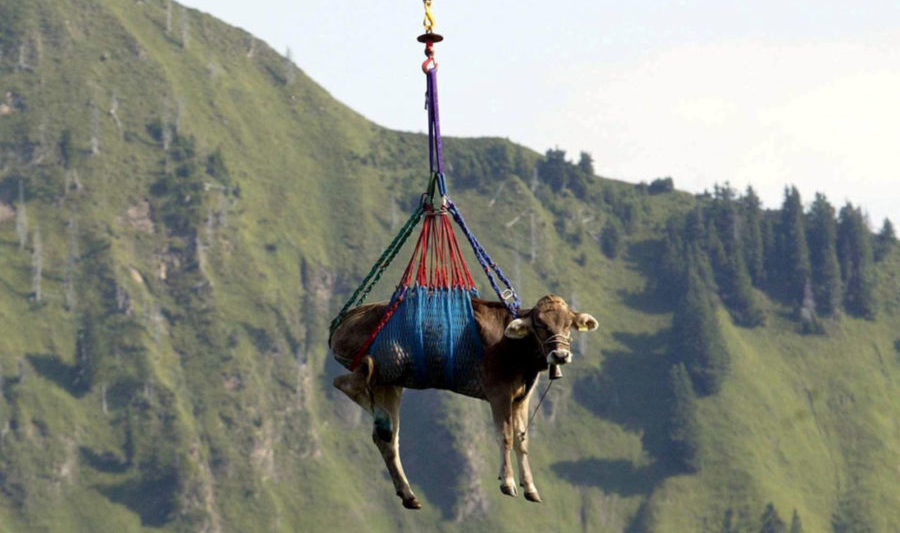* Scientific name for domestic cattle.The cows of Klausenpass, Switzerland, find their way to lower pastures for autumn.
But some cattle become too weak or are unable to make the journey because of age or injury.

From time to time, a hiker through the Swiss Alps might witness a startling sight. First, the sound of a helicopter reverberates off the valley walls. Then the chopper appears, a long cable hanging from its belly. When the burden at the end of the cable heaves into view, it is not a rescued mountaineer, en route to the hospital. Nor is it a pot of cement or a pallet of planks, on the way to a high-mountain building project.
It is a single cow, hanging gently from a harness, her dark eyes alert, her hooves high above the ground.
When the scene is breathlessly described to a Swiss person, the response seems to be incredulity — at your amazement. The cow was hurt. It probably twisted its ankle in the high meadows, and needed to get to a vet. Of course they used a helicopter! It’s the right thing to do.
Look carefully.
This could be a postcard from the future.
This is the Valais — a canton, or Swiss state, known for its milk, cheeses, wine, apricots, and beef. It is one of the largest of Switzerland’s 26 cantons, about the size of Delaware, in a country no larger than Connecticut and Massachusetts put together. In practice, much of that land area is consumed by some of the tallest mountains on the continent. The Valais consists of a tremendous glacial valley sliced through the Alps, running from Lake Geneva past the Matterhorn, and just a few kilometres across at its widest. As you ride the train along the valley bottom towards the capital of Sion, the primary impression is of a miniature quality, with the towns and fields washing up the walls of this thin crack in the earth, like a stream at the bottom of a gorge. On south-facing slopes, it’s sunny enough to grow grapes. On the north-facing side, the shade means the land is used in part for cows.
And what cherished cows! The cow is, for all intents and purposes, the national animal, ubiquitous on T-shirts and postcards and various other Swiss paraphernalia. Bovines feature prominently in the nation’s exports: a rainbow of cheeses are manufactured in Switzerland, often by hand in small alpine huts. The holey ‘Swiss’ cheese most non-Swiss are familiar with is a North American confection inspired by Emmental cheese.
In Swiss cow country, it’s easy to feel that you’re in a land left behind by time. Farmers still take their cows up to the high mountain pastures, called alpages, every spring and bring them down in the fall, in rites like something out of a storybook. The cows are outfitted with their best leather collars and enormous clonking bells, the farming families put on traditional outfits, including dresses and shirts flocked with edelweiss, and they all walk together up to the alpages, where no roads go. When they walk back down in the autumn, the cows wear festive hats, often floral affairs or even small pine trees sporting paper pom-poms.
The ascent, in French-speaking Switzerland, is called La Poya. The descent, in the wet, green days of late September or early October, is called the Désalpe. Being in town when the cows are coming or going is a gustatory and auditory cacophony, with stalls selling local delicacies and bands of historically attired men marching in platoons with cowbells while the stars of the day trickle through in troops of 10 or 15. People turn out from miles around to toast the cows and hear the alpenhorn band play.
Cows are in the news with amusing regularity; they do the darndest things. Papers feature photos of cows that have fallen into swimming pools or wandered on to freeways and must be picked up by their owners. Once, a helicopter pilot told me, a cow in the high mountains accidentally tipped herself into a watering trough. She got firmly wedged, her four feet up in the air, and her owner had to call in the helicopter company. They wrapped straps around her legs, lifted her 50 centimeters (about a foot and a half) off the ground, and set her down to the side. The moment she touched down, she got up and was soon moving off happily, her travails apparently forgotten.
Perhaps one of the most charming encapsulations of the Swiss attitude towards cows is that the farmers name the members of their herds. In one alpage, the list of grazing ladies in the class of 2006 included Laura, Pepsi, Safira, Marushka, Débora, Billi-jean, Alpenrose, Denise, Euro, Pizza, Paprika, Bomba, Vénus, Lolita, and Diane.
What’s the most popular cow name in Switzerland? A farmer thinks for a moment. ‘Fanny, I believe … But there are fashions.’ Last year, the cow that won the Val d’Hérens fighting cow competition was named Schakira. Read more from Aeon




